Posted March 7, 2018
Last modified March 9, 2018
Lobster landings and the value of the catch both decreased in 2017, but Department of Marine Resources officials say the fishery remains strong.
Almost 111 million pounds of lobster were landed in Maine last year, down from 132 million pounds in 2016 and 122 million pounds in 2015. Landings have exceeded 100 million pounds each year since 2011.
The value of the catch was $433 million, according to DMR, down from $540 million in 2016 and $502 million in 2015. Including bonuses paid by lobster coops, the income was $450 million last year.
For context, just ten years ago, in 2007, Maine fishermen landed 64 million pounds at a total value of $280 million.
Despite the dip, DMR Commissioner Patrick Keliher said he remained confident about the strength of the fishery. But since 2012, he has focused on “being ready for a decline,” he told an audience of fishermen at the annual Maine Fishermen’s Forum in Rockport on March 3.
In southern New England, lobster landings dropped by 75 percent in recent years, and “they weren’t prepared,” Keliher said.
“I’m not panicked about this natural variation,” he said, given that the landings were the sixth highest of the last seven years, but he is concerned about the nearly $100 million loss in the coastal economy.
One significant detail of the landings data confirms what fishermen and scientists have been saying—the species is being found in greater abundance north and east. A map presented at the forum showed that in lobster zone A, which runs from Schoodic Point to Calais, 24.6 million pounds of lobster were landed, making up 22 percent of the total catch. Zone G, the southern-most zone, from the New Hampshire border to Portland, saw just 4.1 million pounds landed, 3.7 percent of the total.
Sixty-one percent of the landings were in the easterly three zones, while just 20 percent were caught in the southerly three zones.
At another session at the forum, a 2016 study of the industry completed by Colby College’s Michael Donihue described the lobster fishery’s $1 billion economic impact on the coast. The ancillary businesses, such as dealers who purchase from lobster coops, are often unseen, said Annie Tselikis of the Maine Lobster Dealers Association. In 2016, there were 300 licensed lobster dealers.
“These businesses are really hidden in warehouses,” she said. Donihue added that the sorting and packing work often hires “people that no one else will employ.”
Ancillary businesses include trucking firms, water companies that supply holding tanks, and fuel businesses. The study found that lobster dealers had a direct economic impact of $187 million, supporting 740 jobs. Indirect and induced impacts totaled about $57 million, supporting another 173 jobs.
In all, the study concluded that the annual contribution to the state’s economy was $1 billion, supporting 4,000 jobs.
“It’s the first time we’ve gotten a good sense of the impact of this industry on the Maine economy,” Donihue said.
The full report is available at Colby.edu/lobsters2dollars.

Contributed by




